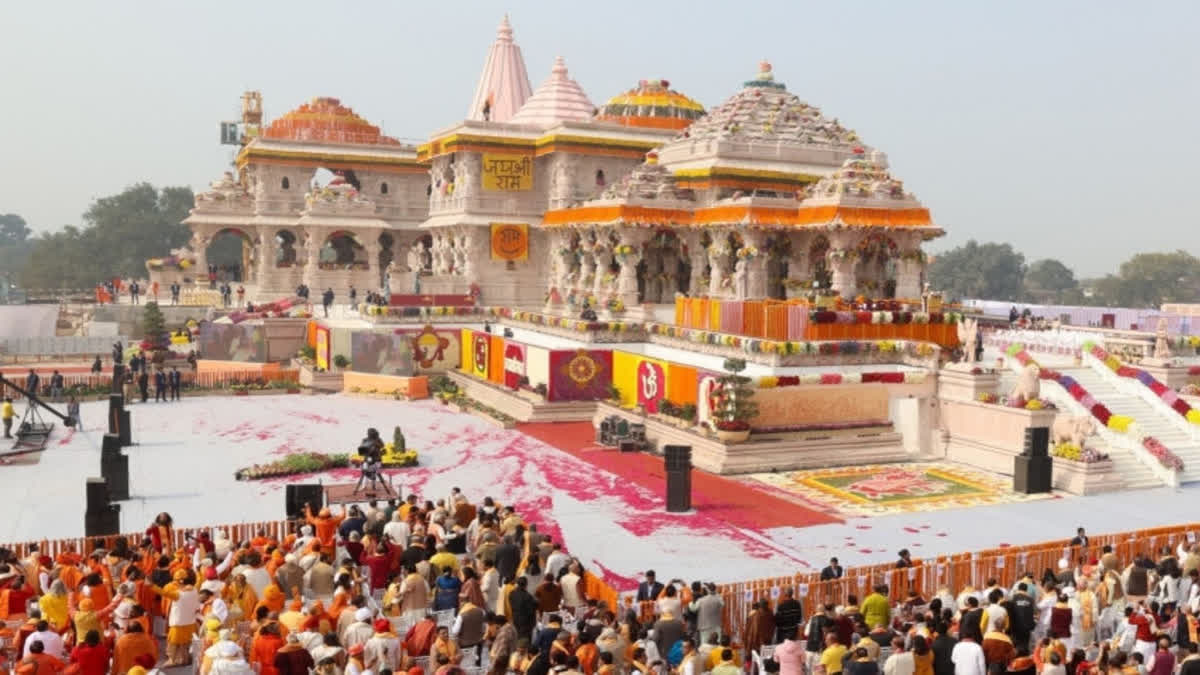On January 22, 2024, a new landmark of India--both structural and spiritual--rose on Ayodhya's horizon in the form of a new-age architectural marvel of elegant sandstones, exquisitely and diligently carved by craftsmen with dedication and devotion to Lord Ram.
The much-awaited Ram Mandir consecration event took place, marking the culmination of one of the most important poll promises of the BJP. The magnificent temple in the city of Ayodhya believed to be the birthplace of the Hindu deity Lord Ram was largely projected as the fruition of the spiritual dream of the Hindus in post-Independent India.
Sprawled over a vast expanse of land, the majestic Ram Temple in Ayodhya was built by overcoming engineering challenges and with due sensitivity to nature. The new Ram Lalla idol was consecrated at an event led by Prime Minister Narendra Modi who said it marked the advent of a new era.
Champat Rai, general secretary of the Sri Ram Janmabhoomi Teerth Kshetra, described the temple's construction as the result of “collective wisdom' of “some of the best brains in the country”. No iron or steel has been used in the construction of the grand structure. Stones have been sourced from Rajasthan's Bansi Paharpur area.
An architectural splendour
The ground was found to be unsuitable for laying the foundation stone, during the excavation work, posing a challenge that engineers overcame by creating an “artificial foundation" over which the superstructure sits.
Images of Lord Hanuman, other deities, peacocks and flower patterns have been carved onto the stones, lending the structure a divine look. More than 3,000 kg of flowers of over 20 varieties have been used to decorate the grand structure.
Around the grand temple is a rectangular periphery called percota, a feature found in temples in south India, but not generally in north India. The percota was 14 feet wide and the periphery span 732 metres. Ornate statues of elephants, lions, Lord Hanuman and Garuda were installed at the main entrance leading to the temple earlier this month. These idols have also been made using sandstone brought from Bansi Paharpur. A major part of the temple compound was covered with green dotted with hundreds of trees. Important features such as its own sewage and water treatment plants, a fire brigade post and a dedicated electricity line are other highlights.
About 70 per cent of the complex was covered with green area, which includes dense and, in some segments, where even sunlight hardly filters through. About 600 existing trees are preserved in the green belt. The complex consisted of two sewage treatment plants-- a water treatment plant and a dedicated electricity line from the powerhouse--the fire brigade sourced water from an underground reservoir.
SC verdict & controversy
The Supreme Court delivered a historic verdict in 2019, settling the temple-mosque dispute that dated back over a century. The apex court backed the construction of the Ram temple at the disputed site. It ruled that an alternative five-acre plot must be found for building a mosque. Later, the Uttar Pradesh government allotted the land for the mosque in the Dhannipur area of Ayodhya district.
The Ram Mandir has been mired in controversy, which snowballed into a major political row as religious tension prevailed in India for decades. The primary reason for this is that the site where the temple is being constructed was home to a mosque, the Babri Masjid (Mosque of Babur), which was dismantled by a mob on December 6, 1992.
The controversy resulted in nationwide riots in 1992 that killed 2,000 people after the mob destroyed a 16th-century mosque that had stood there. Hindus contended that they had been robbed of the right to worship at the site of the unused Babri Masjid, which they said had been built over the ruins of a Hindu temple.
The then Prime Minister Rajiv Gandhi of the Congress Party opened the locks of the mosque for worship in 1986. However, the movement to build a temple at the spot of the mosque gathered steam with the Ram Rath Yatra, a pilgrimage across the country to Ayodhya in 1990 led by the then-president of the BJP, Lal Krishna Advani.
In 1992, a violent mob demolished the mosque after a religious procession converged on Ayodhya. The agitation for a Ram Mandir, which was undertaken by the Hindutva organisations, helped transform the BJP into the largest party in the 1996 Lok Sabha elections. Subsequently, multiple BJP election manifestos included a pledge to build a Ram Mandir. Even though the quest to build the temple has been intertwined with politics and communalism. The BJP benefited electorally.
Consecration a gala affair
There was unprecedented enthusiasm and frenzy over the Ram Lalla consecration in Ayodhya. The atmosphere was surcharged with unprecedented joy as people looked for daily updates about the temple. Sweets were distributed, and people dressed up as figures from Ram’s life and danced in the streets. The Ram Lalla Pran Pratishtha was attended by about 7,000 guests, including Bollywood celebrities, prominent athletes, business tycoons and spiritual leaders, among others.
PM Modi presided over the ceremony while BJP workers went from door-to-door in Delhi to invite residents to the temple after the consecration ceremony, theatres such as PVR INOX hosted live streams for viewers, TV channels aired the consecration ceremony live, and airlines offered special flights between Delhi and Ayodhya on the inauguration day. The day after the temple’s inauguration, roughly 3,00,000 devotees thronged the temple for the darshan of the newly installed deity.
Govt projects tourism push
The government pumped in $10 billion in infrastructure, including roads, a new airport terminal, and railway station upgrades in Ayodhya to woo up to 50 million tourists every year. The Labour and Employment Ministry eyes about 5,00,000 jobs directly or indirectly related to the hospitality sector to be created in the area before 2030. Several hotels and townships were expected to be developed in the months following the consecration, and property prices in the area skyrocketed.



